Introduction to Pointers
Pointers are variables that hold address of another variable of same data type.Pointers are one of the most distinct and exciting features of C language. It provides power and flexibility to the language. Although pointer may appear little confusing and complicated in the beginning, but trust me its a powerful tool and handy to use once its mastered.
Benefit of using pointers
- Pointers are more efficient in handling Array and Structure.
- Pointer allows references to function and thereby helps in passing of function as arguments to other function.
- It reduces length and the program execution time.
- It allows C to support dynamic memory management.
Concept of Pointer
Whenever a variable is declared, system will allocate a location to that variable in the memory, to hold value. This location will have its own address number.Let us assume that system has allocated memory location 80F for a variable a.
int a = 10 ;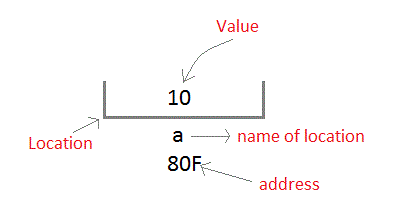
Declaring a pointer variable
General syntax of pointer declaration is, data-type *pointer_name;
Data type of pointer must be same as the variable, which the pointer is pointing. void type pointer works with all data types, but isn't used oftenly.
Initialization of Pointer variable
Pointer Initialization is the process of assigning address of a variable to pointer variable. Pointer variable contains address of variable of same data type. In C language address operator& is used to determine the address of a variable. The & (immediately preceding a variable name) returns the address of the variable associated with it.int a = 10 ;
float a;
int *ptr;
ptr = &a; //ERROR, type mismatch
Dereferencing of Pointer
Once a pointer has been assigned the address of a variable. To access the value of variable, pointer is dereferenced, using the indirection operator*.
int a,*p;
a = 10;
p = &a;
printf("%d",*p); //this will print the value of a.
printf("%d",*&a); //this will also print the value of a.
printf("%u",&a); //this will print the address of a.
printf("%u",p); //this will also print the address of a.
printf("%u",&p); //this will also print the address of p.
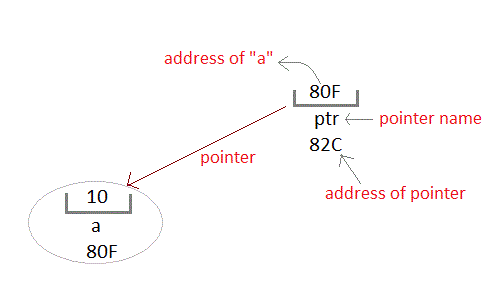
Pointer and Arrays
When an array is declared, compiler allocates sufficient amount of memory to contain all the elements of the array. Base address which gives location of the first element is also allocated by the compiler.Suppose we declare an array arr,
int arr[5]={ 1, 2, 3, 4, 5 };
Assuming that the base address of arr is 1000 and each integer requires two byte, the five element will be stored as follows

arr is equal to &arr[0] // by default
We can declare a pointer of type int to point to the array arr.int *p;
p = arr;
or p = &arr[0]; //both the statements are equivalent.
Now we can access every element of array arr using p++ to move from one element to another.
NOTE : You cannot decrement a pointer once incremented.
p-- won't work.Pointer to Array
As studied above, we can use a pointer to point to an Array, and then we can use that pointer to access the array. Lets have an example,int i;
int a[5] = {1, 2, 3, 4, 5};
int *p = a; // same as int*p = &a[0]
for (i=0; i<5; i++)
{
printf("%d", *p);
p++;
}
In the aboce program, the pointer *p will print all the values stored in the array one by one. We can also use the Base address (a in above case) to act as pointer and print all the values.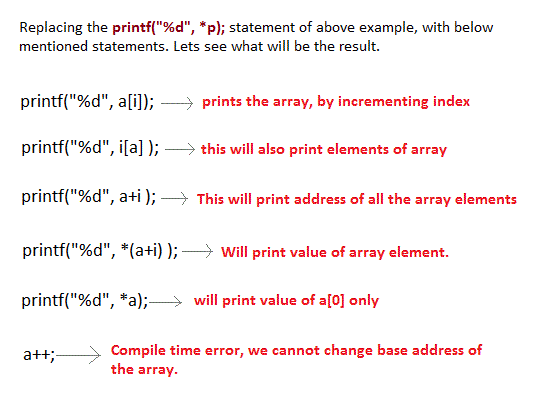
Pointer to Multidimensional Array
A multidimensional array is of form,a[i][j]. Lets see how we can make a pointer point to such an array. As we know now, name of the array gives its base address. In a[i][j], a will give the base address of this array, even a+0+0 will also give the base address, that is the address of a[0][0] element.Here is the generalized form for using pointer with multidimensional arrays.
*(*(ptr + i) + j) is same as a[i][j]
Pointer and Character strings
Pointer can also be used to create strings. Pointer variables of char type are treated as string.char *str = "Hello";
This creates a string and stores its address in the pointer variable str. The pointer str now points to the first character of the string "Hello". Another important thing to note that string created using char pointer can be assigned a value at runtime.
char *str;
str = "hello"; //Legal
The content of the string can be printed using printf() and puts().printf("%s", str);
puts(str);
Notice that str is pointer to the string, it is also name of the string. Therefore we do not need to use indirection operator *.
Array of Pointers
We can also have array of pointers. Pointers are very helpful in handling character array with rows of varying length.char *name[3]={
"Adam",
"chris",
"Deniel"
};
//Now see same array without using pointer
char name[3][20]= {
"Adam",
"chris",
"Deniel"
};
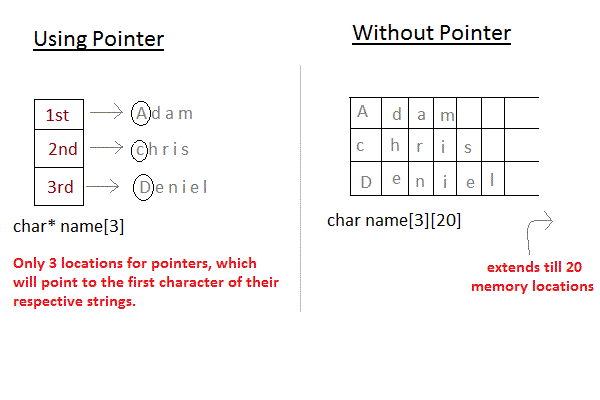
Pointer to Structure
Like we have array of integers, array of pointer etc, we can also have array of structure variables. And to make the use of array of structure variables efficient, we use pointers of structure type. We can also have pointer to a single structure variable, but it is mostly used with array of structure variables.
struct Book
{
char name[10];
int price;
}
int main()
{
struct Book a; //Single structure variable
struct Book* ptr; //Pointer of Structure type
ptr = &a;
struct Book b[10]; //Array of structure variables
struct Book* p; //Pointer of Structure type
p = &b;
}
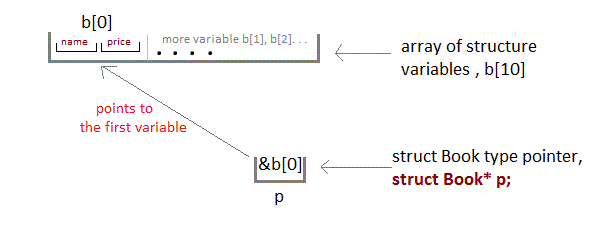
Accessing Structure Members with Pointer
To access members of structure with structure variable, we used the dot . operator. But when we have a pointer of structure type, we use arrow -> to access structure members.
struct Book
{
char name[10];
int price;
}
int main()
{
struct Book b;
struct Book* ptr = &b;
ptr->name = "Dan Brown"; //Accessing Structure Members ptr->price = 500;
}
Pointer Arithmetic
Pointer arithmetic is very important to understand, if you want to have complete knowledge of pointer. In this topic we will study how the memory addresses change when you increment a pointer.16 bit Machine ( Turbo C )
In a 16 bit machine, size of all types of pointer, be it int*, float*, char* or double* is always 2 bytes. But when we perform any arithmetic function like increment on a pointer, changes occur as per the size of their primitive data type.Size of datatypes on 16-bit Machine :
| int or signed int | 2 |
| char | 1 |
| long | 4 |
| float | 4 |
| double | 8 |
| long double | 10 |
Examples for Pointer Arithmetic
Now lets take a few examples and understand this more clearly.int* i;
i++;
In the above case, pointer will be of 2 bytes. And when we increment it, it will increment by 2 bytes because int is also of 2 bytes.float* i;
i++;
In this case, size of pointer is still 2 bytes. But now, when we increment it, it will increment by 4 bytes because float is of 4 bytes.double* i;
i++;
Similarly, in this case, size of pointer is still 2 bytes. But now,
when we increment it, it will increment by 8 bytes because its data type
is double.32 bit Machine ( Visual Basic C++ )
The concept of pointer arithmetic remains exact same, but the size of pointer and various datatypes is different in a 32 bit machine. Pointer in 32 bit machine is of 4 bytes.And, following is a table for Size of datatypes on 32-bit Machine :
| int or signed int | 4 |
| char | 2 |
| long | 8 |
| float | 8 |
| double | 16 |
No comments:
Post a Comment
Thank for your feedback.